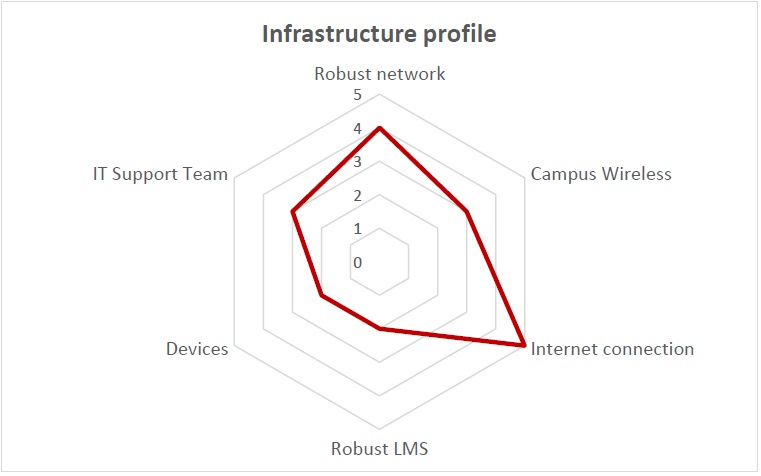Follow these guidelines to create a technology infrastructure that support teachers and students
Most educational organizations want the classroom to change; to improve teaching and learning by leveraging technology. The terms blended and flipped learning are touted extensively as useful educational goals.
However, to increase the probability of long term success and to reduce teacher/instructor frustration, organizations need to ensure that the broader fundamentals are in place before asking teachers to change. This is true whether the organization is a large university or school district, an eLearning business, or a small school of a few hundred students. (Note that I am not talking about the success of the “lone experimenters;” the innovators and early adopters who will implement change no matter what the environment is like. I am talking about organization wide long term success.)
Fundamentals fall into a number of categories. I will consider one (infrastructure) in this article and others in companion articles.
If teachers walk into a lesson and the technology regularly fails, even for just a few minutes, they lose confidence. They become frustrated and lose commitment (and who could blame them?).
For long term change to occur, the technology behind the scenes must be like the electricity system in a modern country – it must “just work” – all the time and every time. It must be invisible. If it fails, it must be able to be fixed quickly and painlessly.
Infrastructure requirements
Thus, there are some requirements for change in the classroom to begin. This is not an exhaustive list, but it contains some major points.
While reading these points, rate your organization on a scale of 1 (Poor) to 5 (Excellent).
1. A solid, reliable, well designed network
a. The network (servers, switches, operating systems) must be fast and reliable. They must work virtually all the time. Logons should be fast and easy. Accessing systems (network drives, online resources, etc.) must be fast and efficient.
b. Preferably there should be SSO (Single Sign On) for most resources. Staff and students should have one user name and password that works across all major systems, not a different password for each system. If a password is changed, the change should flow through to all systems.
2. A fast, stable, campus wide wireless network
a. Wireless access is a key part of many modern organizations. The wireless network must “just work”. It should be easy to access, reliable and fast. It should saturate the entire campus, with limited or no areas with weak signal.
3. A fast and reliable internet connection
a. Access to the internet must be fast and reliable. It needs to be of sufficient speed even when it is being accessed by most students and teachers.
b. It must also provide fast and reliable external access to teaching and learning resources that are on campus. Thus, the connection speed into the organization and the connection speed out of the organization both need to be fast.
4. A robust and feature rich LMS (Learning Management System)
a. Modern systems have moved beyond the old concept of a LMS, and are really much more than they were 10 or 15 years ago. I prefer to call the ones that have evolved Online Learning Environments (OLEs). The focus is on the learning, not just managing the learners.
b. The system being used must fit the educational needs of the organization now and in the coming years. Staff need to know that it will grow with them to provide capabilities that they may not have thought of yet. (I know of organizations that have had four LMS in a decade, hoping each time that the newest one will be “right”. I know of schools who invested in a system that didn’t suit their needs and then wanted staff to change to “something better” two years later – after staff had invested time and energy learning the system and creating resources for use on the system.) Teachers deserve better.
c. Research, understanding and planning are vital. These aspects need to be done by eLearning staff; staff who understand technology and teaching and learning. This is not an IT decision. The IT department is important to ensure that the technical aspects are appropriate, but the LMS is a tool to enhance learning, not IT.
5. Reliable and suitable devices (laptop computers) for staff
a. If we want staff to embrace technology to enhance learning and teaching, we need to provide them with devices that empower them. The devices need to be powerful enough to do what needs to be done, and reliable enough that they do not frustrate staff.
b. The devices also need to align with the educational goals of the organization. For example, my school provided Surface Pro 3 devices to all staff as the educational goals required the power of a full laptop computer, the form factor of a tablet and the advantages of “real” granular stylus enabling digital ink and digital paper (as compared to the rather primitive touch capabilities provided by some tablet devices).
c. It is then a matter of budgeting, and this can be difficult. However, it is a barrier that must be overcome. Money must be found to provide devices to staff, and then money must be found to provide enough professional development for staff to use the devices effectively.
6. A friendly, supportive, efficient IT support team. There are several important factors here.
a. The team must be friendly and supportive. They must treat each person with respect and be genuinely interested in helping to solve the current problem, even if they have seen the same problem by the same person a few times. The aloof IT support person who treats the teacher or student as lacking knowledge or being an inconvenience has no place in an organization that is moving forward. Staff and students must feel comfortable when they ask for support.
b. They must be experts in all aspects of the technology within the organization, or must be able to source solutions quickly. Reporting a problem and having it fixed a week later, with little or no communication in between, just doesn’t work.
c. Is it possible to have a “dream team” with all of the skills and the appropriate attitude? The short answer is yes, and if you are lucky enough to have one, ensure that they know that they are appreciated.
An organization with everything in place, ready to support change in the classroom, would score 5 in each of these areas. The resulting graph would look like the one below.
However, an organization that wasn’t prepared as well may have a graph that looks like the next one. This organization is not ready to implement technology enhanced learning.
The leadership of the organization needs to work to get the scores closer to a 5, making the graph larger and smoother. This will result in a greater probability of success.
What does the graph for your organization look like?
Creating change in teaching and learning doesn’t happen only in the classroom. It requires the background infrastructure to be robust, reliable and suitable for the task. However, it is only when this environment is appropriate that educators at the coalface can successfully implement change.
- TC- What student choice and agency actually looks like - November 15, 2016
- What student choice and agency actually looks like - November 14, 2016
- App of the Week: Science sensor meets your smartphone - November 14, 2016




